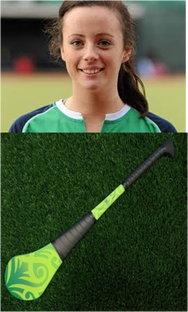
I met these two individuals in Tom's house in the summer of 2009. I accompanied a graduate student who was interviewing Tom and John for her masters dissertation. The graduate student was Aine Connery. Aine played both hockey and camogie at the highest levels. She was a key member of the Irish international hockey team that narrowly failed to qualify for the 2012 London Olympics. She was also prominent in Kilkenny camogie circles. Aine was aware of how the hockey stick had evolved from timber (mulberry) to graphite. She was interested in the implications for camogie/hurling of the carbon fibre stick starting to gain market share. As a result, we found ourselves in Ferbane. (Given the wonderful scones provided in the Wright household one could understand why Offaly hurlers might carry a few extra pounds. That said there is a problem with this line of reasoning as Tom is a Tipperary native.)
Tom and John explained to Aine how they had gone through a long, slow process to develop their product. It was a labour of love. The genesis of the idea arose out of the shortage of ash for timber sticks during the 1970s and 1980s. A plastic piping company, Wavin, had developed a plastic stick. The Wavin product failed to gain market share due to the vibrations it transmitted to the hurler's hands. It was also deemed potentially dangerous because it did not break easily, and when it did break, it did not do so in a predictable way. The importance of a breaking point in their product was something that Tom and John found was crucial in their efforts to persuade the GAA to give the Cultec stick its blessing.
There was only one rule in the GAA rulebook that the Cultec product had to satisfy. The rule specified a limit on the size of the strike zone (the bas). At its widest point it was only to be 13cms. The initial prototype developed by Tom and John satisfied this rule. The problem was that players were not happy with this small bas. It was only then that Tom and John discovered that the rule was rarely observed or enforced. Most adult players have a stick that has a strike zone that exceeds the limit. There was little interest in a product with a small strike zone. It was back to the drawing board.
The product was being tested in Athlone Institute of Technology. The tests suggested the Cultec product had a larger sweet spot for striking and that it possibly hit the ball further than the timber stick. The tests also revealed a product that was more durable than the timber competitor. This durability partly explains why the Cultec stick selling price is slightly higher than the timber stick.
In an effort to break into the market for younger players, the Cultec stick came in a variety of colours. Pink was a popular colour with camogie players. In recent years they have tended to focus on the timber coloured sticks. To date, much of Cultec's success is based on the uptake in their product amongst younger players. It is only beginning to have an impact at the higher levels of the game. This weekend the Allianz National Hurling League starts. The poster boy for Cultec is Dublin hurler Ryan O'Dwyer. Cultec feel confident that the number of high profile players using the stick will increase.as those who have used it as a kids get older.
The carbon fibre stick is here to stay. It has captured enough of the market to make Cultec a viable commercial venture. While it is too early to say what impact the Ash Dieback disease will have on the availability of timber, it must be reassuring to the GAA to know there is a viable alternative. Cultec will be around long after the debate about the size of the bellies, legs and arses of the Offaly hurlers has subsided.
 RSS Feed
RSS Feed